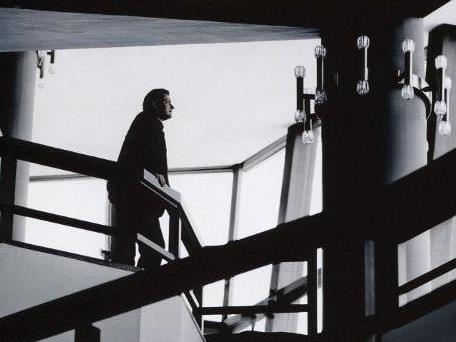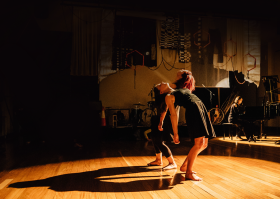Album cover: Bruckner Symphony No 3 in D minor WAB 103 and Wagner Tannhäuser Overture. Image via Deutsche Grammophon.
Bruckner wrote 11 Symphonies in all, though one is an early unnumbered work, one is called ‘Symphony 0’ and there are multiple versions to almost all of them. It is generally accepted that there are nine works in the genre. The composer was foremost a symphonist whose skills in this form are unique. It has been argued that Bruckner’s apparent lack of direct lineage or successors diminishes his stature. Others see a valid connection between Wagner and Mahler, though rarely matching either. Bruckner’s many versions and editions of his symphonies have confused and certainly not aided his cause. This work, perhaps the most problematic, has no less than five editions: an 1872-73 version (published by Nowak, rejected by the Vienna Philharmonic three times and first performed in the Adelaide Festival of the Arts in 1978), an 1874 version, and 1876 version of the Adagio, an 1877 version (published by Oeser) republished with the Scherzo by Nowak, and an 1888-89 version (published by Nowak) recorded here, all quite individual conceptions.
Bruckner suffered from the perception that he was an antisocial eccentric, a Christian simpleton, country bumpkin and provincial schoolmaster ‘mad about God’. And there is the old untrue adage that he wrote the same symphony nine times. His symphonies are mostly structured over four movements and gradually became longer in duration, his third is nearly an hour long while his eighth is an hour and a quarter. Of further detriment to Bruckner (and to Wagner) is that unfortunately Adolf Hitler was a big fan, publically consecrating a bust at the national Walhalla Temple near Regensburg in 1937 whilst accompanied by the seventh symphony’s Adagio. This same long movement was also broadcast in 1943 before the announcement of the German defeat at Stalingrad, and before Reich President Karl Dönitz announced Hitler’s death on Radio Berlin, using a recording by Furtwängler.
Bruckner’s Symphony No 3 is dedicated to Richard Wagner, Bruckner’s idol and friend. The work has reminiscences throughout of Tristan und Isolde (in the second movement), Walküre, Tannhäuser (in the final movement) and Die Meistersinger. Its first performance in Vienna in 1877 conducted by the composer was a howling failure with the audience and indeed members of the orchestra leaving before the performance ended. Mahler reportedly sat it out. The manuscript of the 1872-73 score with dedication to Wagner was taken by Alma Mahler to the United States in 1940.
Latvian-born Andris Nelsons is currently music director of the Boston Symphony Orchestra and is designated Kapellmeister of the Gewandhausorchester Leipzig, with the appointment commencing in February next year. The orchestra has had a long and important association with Bruckner’s symphonies, including the first performance of the seventh in 1884, a work that is programmed for the conductor’s inauguration concert in February, 2018 when the Gewandhaus will also celebrate its 275th anniversary.
This live recording (June, 2016), released earlier this year, is part of a cycle being undertaken by the Gewandhausorchester under Andris Nelsons with Deutsche Grammophon. There is an engaging feeling of authenticity and respect. Nelsons has a humble approach to the work that seeks spaciousness and spirituality, writing in the liner notes, “[Bruckner] does not convey one truth, but rather compels the listener to follow his mystical path – a pilgrimage of sorts that will bring him closer to God. This notion is particularly evident in this symphony’s second movement, perhaps the work’s emotional core.”
The Leipzig orchestra is superb throughout, providing a mature and moving account with intense focus on the work’s temperaments and meanings even across its most ambiguous passages. Recorded in a soft and expansive acoustic of the Gewandhaus, the opening Gemäßigt, mehr bewegt, misterioso’s austere and mysterious opening swells wonderfully to the opening statement of the theme over a D minor arpeggio that cyclically binds the whole work. The tender and shadowed second subject in descending strings and horn melts in. Throughout passages of sonorous luxury like static blocks permit the listener to linger. The song-like Adagio, bewegt, quasi Andante sails along song-like in strings and hovering winds. The Ziemlich schnell with its Ländler Trio has a wonderful buoyancy and the Finale Allegro takes another abrupt directional change with a hymn-like quotation from Tannhäuser. It was then a highly enjoyable experience to hear Wagner’s Tannhäuser Overture connected to the Symphony presenting some of the finest playing on the recording.
Based on this recording we can only assume that under the tenure of Nelsons the Gewandhausorchester is about to take pre-eminence in this late-Romantic repertoire.
Rating: 41/2 stars out of 5
Bruckner Symphony No 3 in D minor WAB 103 and Wagner Tannhäuser Overture
Gewandhausorchester
Andris Nelsons, conductor
0289 479 7208 2





